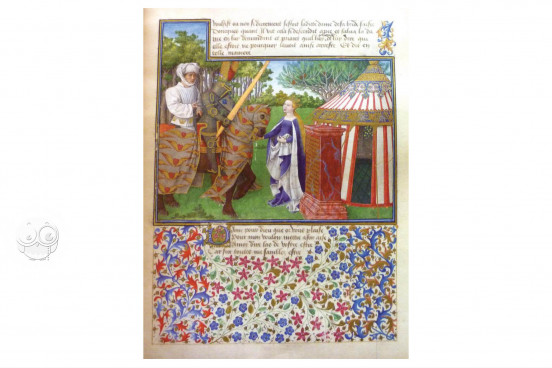The Vienna manuscript of the Book of Love of René d'Anjou—also known as the Livre du cueur d'amour espris (Book of the Heart of Love's Captive)—was copied and illuminated around 1465-1470 for the text's author, René I (1409-1480), Duke of Anjou and King of Naples and Jerusalem. The book must have been created in the orbit of René's court, probably in Anjou or Provence. It boasts sixteen large miniatures of exceptional quality by the anonymous Master of King René of Anjou, renowned for his brilliant evocation of natural lighting effects.
The manuscript's text is René of Anjou's most ambitious and influential literary work, an allegorical romance in French that relates the adventures of a knight named Heart and his page, Desire, as they seek to liberate Sweet Grace from Denial, Shame, and Fear.
Chivalrous Adventures
The protagonist—portrayed as a knight in full armor, his horse's saddlecloth covered with winged hearts—represents the author's heart in a dream vision. The miniatures depict his encounters with a range of allegorical figures—including Hope (a crowned woman; fols. 5v and 21v), Jealousy (a hairy dwarf; fol. 9r), and Generosity (a youth; fols. 47v and 51v)—and a Black Knight, with whom he must do battle (fols. 18v and 21v).
Each scene is restricted to a few figures in a landscape setting. The master often uses nuanced coloration and gold to evoke a particular time of day—dawn (fols. 15r and 31v), twilight (fol. 47v), night (fols. 2r and 12v). He imbues his scenes with grace and often with pageantry, as in the miniature of Desire Kneeling before Honor (fol. 33r).
An Artist of Exceptional Talent
The illuminator, sometimes called the René Master, is named for his work illuminating manuscripts for the duke, including a copy of the duke's description of an ideal tournament (Paris, Bibliothèque nationale de France, MS fr. 2695), a manuscript that, like the Book of Love, displays his interest in lighting effects and pageantry. It has been speculated that he trained in the Netherlands or central France.
The identity of the René Master has been a matter of much speculation, and many scholars believe him to be Barthélemy d'Eyck, who is documented as having served René with a variety of responsibilities for twenty-three years and who is described in one instance as a painter.
Elegant Presentation
Rene's romance is in a mixture of French prose and verse. It is written in the favored script for secular texts, French Bâtarde, with painted initials introducing major textual divisions, and with borders comprising rinceaux motifs on the pages with miniatures. The portions in verse on the pages with miniatures feature painted line fillers, whose alternating blue and red color help to articulate the rhyming couplets.
A Project Unfinished
A masterpiece with its sixteen completed miniatures, the manuscript would have been even more richly illuminated had the twenty-nine blank spaces reserved for miniatures been filled. It is unknown why the project was abandoned or how the unfinished manuscript came into the hands of Eugene, Prince of Savoy (1663-1737). His library was acquired upon his death for the Austrian Imperial Library, renamed the Österreichische Nationalbibliothek after World War II.
We have 1 facsimile edition of the manuscript "Book of Love of René d'Anjou": Libro del Corazón Prendido facsimile edition, published by Reales Sitios, 2007
Request Info / Price
